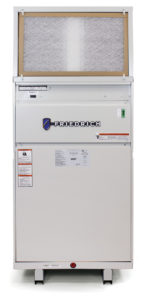NATIONAL REPORT—Air conditioning is a major factor in helping to keep guests comfortable. But while an air conditioning unit can control the temperature of the room, it doesn’t always maintain a comfortable humidity level.
Reaching the proper temperature often takes precedence over humidity control. “Every air conditioner is a dehumidifier because it has the ability to remove latent load or moisture from the air by drawing the room air across a cold coil; on that surface, the moisture condenses on the coil and rolls down and goes to the drain pan,” said TJ Wheeler, VP of product management, Friedrich. “They all dehumidify, leading to comfort. The challenge with that is when the room still needs to be dehumidified, but you have already reached the temperature set point. The dehumidification stops because you have also turned off the air conditioner.”
Controlling the amount of humidity in a guestroom is important for several reasons. “First and foremost, the level of humidity directly relates to guest comfort,” said Rob Lafleur, director, product management, Zoneline, GE Appliances, a Haier Company. “You can have a room at the temperature you want, but if the humidity is too high, it could feel extremely cold and clammy. Or, you can feel hot and sweaty if the humidity level is not in the optimum range.”
Chad Burow, director of sales, Telkonet, agreed. “If you go into a property in Florida, for example, where there tends to be a lot of hard surface flooring, that flooring can get slick from the amount of moisture in the room,” he said. “The actual bedding can feel damp. It leads to a poor customer experience.”
High humidity can also lead to mold and mildew issues. “The worst case scenario is when mold develops in the guestroom and that can take a room out of service to mitigate that mold,” he said. “The hotel loses revenue from that room being out of service and it takes on an additional expense to mitigate that room. In some cases, depending on how the mold is, that expense can be very costly.”
It can also cause other long-term problems for the property. “It can lead to all kinds of things, even premature rust on metal surfaces,” he said. “If that moisture in the room is to the point where it is not healthy, it isn’t safe and it isn’t comfortable, then it is a bad thing for the property.”
There are several ways to try and lower humidity in a room. “If you have rooms that are having humidity problems, the first thing I recommend is trying to run your current PTAC just on low speed instead of high speed,” said Lafleur. “That will reduce your overall capacity and let the unit run longer, but it will also increase your dehumidification rate on low speed. That may solve the entire problem right there without having to spend extra money on new hardware.”
If that solves the problem, that means the PTAC might be oversized for that room.
Wheeler said that putting the right size product in the hotel guestroom is very important. “We have really worked a lot with our specifying reps, building design engineers, owners and developers to make sure that we are putting the right size product in these hotels,” he said. “Even though, as a guest, it seems like these are cookie-cutter rooms and buildings, conditions vary greatly—not only based on geography, but proximity to bodies of water or directional facing. Some may get more sunlight than another, and the other side has more or less latent load, so sizing the units properly is a huge first step.”
He also said that price should not be the main factor when considering a PTAC unit. “When you are laying out a building, especially in new-construction or major remodels, really consider the total cost involved—not just upfront cost of just one piece of equipment versus another, but what is this piece of equipment going to be able to do for you,” he said. “If you are in a high-humidity area with very high occupancy rates, what seemed like big gaps in unit-type costs going from a PTAC to a vertical to a vertical with active dehumidification may seem like big jumps, but if you look at what it does from a guest satisfaction perspective, from an upholstery and interior perspective—meaning that you don’t have to change out the interiors because they haven’t gotten moldy or mildewy or even just have acquired odors—that math starts to work out much more quickly than you might think.”
The PTAC unit may not be the cause of the high humidity. “A lot of times, people are quick to jump on the PTACs being the problem for mold and mildew issues, said Lafleur.
“The question is where is the water coming from in the first place? It has to be coming into that room from outside somewhere,” he said. “Sometimes it is an oversized bathroom vent fan that is causing negative pressure in the room that is then pulling negative air in through the cracks and ill-insulated parts of the guestroom. That is really where you have to get a handle on the moisture because there is only so much a PTAC can do if you are just pulling in hot, humid air from outside the property.” HB


